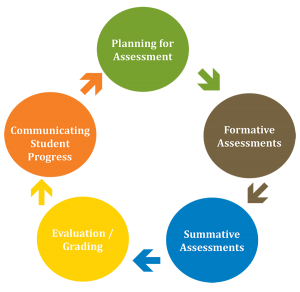
Principle #7
Assessment methods must be differentiated to meet students’ diverse needs, interests, and learning styles.
“Differentiated assessment requires that teachers understand how to offer students different ways to demonstrate learning, while maintaining the integrity of the learning targets to be assessed.”
—Cooper, 2011, p. 5
Universal Design for Learning (UDL) and differentiation provide systemic approaches to setting goals for students and developing sound assessment practices. Differentiated assessment requires teachers to have a clear understanding of the learning needs of their students. This can be determined through routine pre-assessments. Pre-assessment data allows the teacher to determine a student’s readiness and background knowledge prior to instruction. This information is used to develop entry points for instruction, and design specific lesson topics and formats to optimize learning. Pre-assessments also provide teachers with baseline data in order to effectively and accurately measure a student’s progress from the beginning to the end of the instructional period.
Key principles of differentiated assessment include tracking learner progress related to the learning targets, supporting planning to ensure continued growth, and allowing students appropriate summative assessment options for demonstrating what they know, can do and understand.
Differentiated formative assessments provide opportunities for teachers to monitor and adjust for intervention as a need emerges. Summative assessments should offer varied modes of expression and be scaffolded to support all learners. In order to be responsive to a student’s needs, options for the demonstration of knowledge, skill and understanding need to be provided.
ASSESSMENT CYCLE

TRY THIS
Click here for ideas to try in the classroom
Pre-assess students’ needs, interests and learning preferences as the starting point for differentiation. Examples include:
- Collect formative assessment data before, during and after teaching and learning experiences.
- Provide alternative methods and choices for students to demonstrate their knowledge, understanding and skills.
- Incorporate Universal Design for Learning practices.
- See Teaching to Diversity Checklist for examples of adaptations that could be made to curriculum, instruction, and assessment.
- Meet with school based learning services teachers to co-plan and co-teach to support differentiation.
- Provide opportunities to challenge students within their level of understanding. Explore Bloom’s Taxonomy or Webb’s depth of knowledge.
- Create a choice board of different ways that students could demonstrate their learning.
WATCH THIS
Click here to watch related video content
Rethinking Assessment in the UDL Classroom
With all the flexible strategies in the classroom, students need to know how they are being assessed. Educators share how they assess student learning and understanding in a UDL classroom. Learn more.
READ THIS
Click here for additional reading suggestions
To learn more, check out these texts:
- Shelley Moore Website.
- Cooper, D. (2011). Redefining Fair: How to Plan, Assess and Grade for Excellence in Mixed-Ability Classrooms. Bloomington, IN, Solution Tree Press.
- Tomlinson, C.A. and McTighe, J. (2006). Integrating Differentiated Instruction and Understanding by Design. Association for Supervision and Curriculum Development, Virginia, US.
- BC Ministry of Education (2009b). A Guide to Adaptations and Modifications. Victoria, BC, Ministry of Education.
- NVSD Inclusion Education Handbook.
